Jackson M.J. Micro and Nanomanufacturing
Подождите немного. Документ загружается.

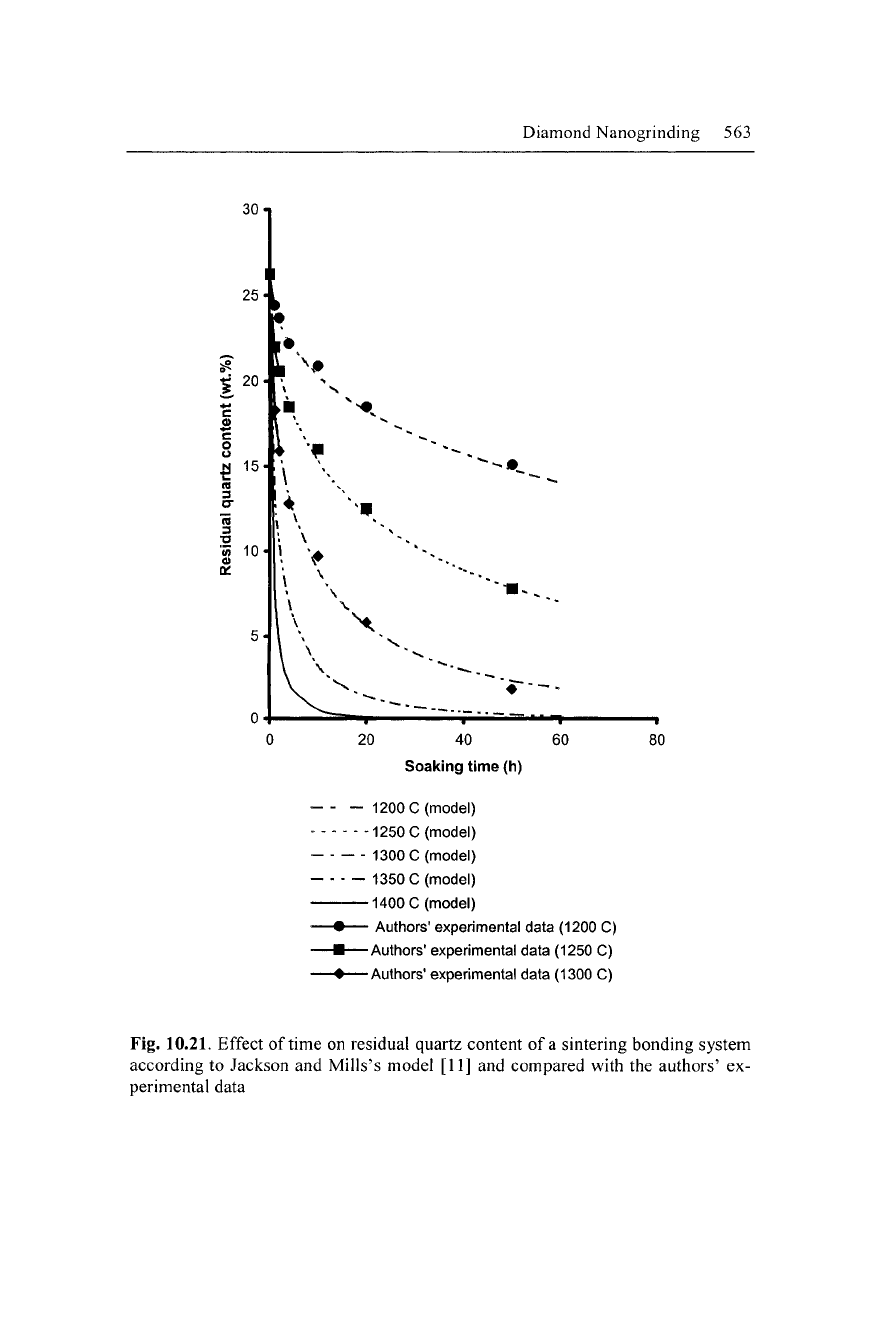
Diamond Nanogrinding 563
301
25
20
-I
IS
15
3
3
10
4
'•"•.
4
\ >
X
20
i
40
Soaking time (h)
—I—
60
80
- - 1200 C (model)
- - - -1250 C (model)
1300 C (model)
1350 C (model)
— 1400 C (model)
• Authors' experimental data (1200 C)
-•—Authors' experimental data (1250 C)
• Authors' experimental data (1300 C)
Fig.
10.21.
Effect of time on residual quartz content of a sintering bonding system
according to Jackson and Mills's model [11] and compared with the authors' ex-
perimental data
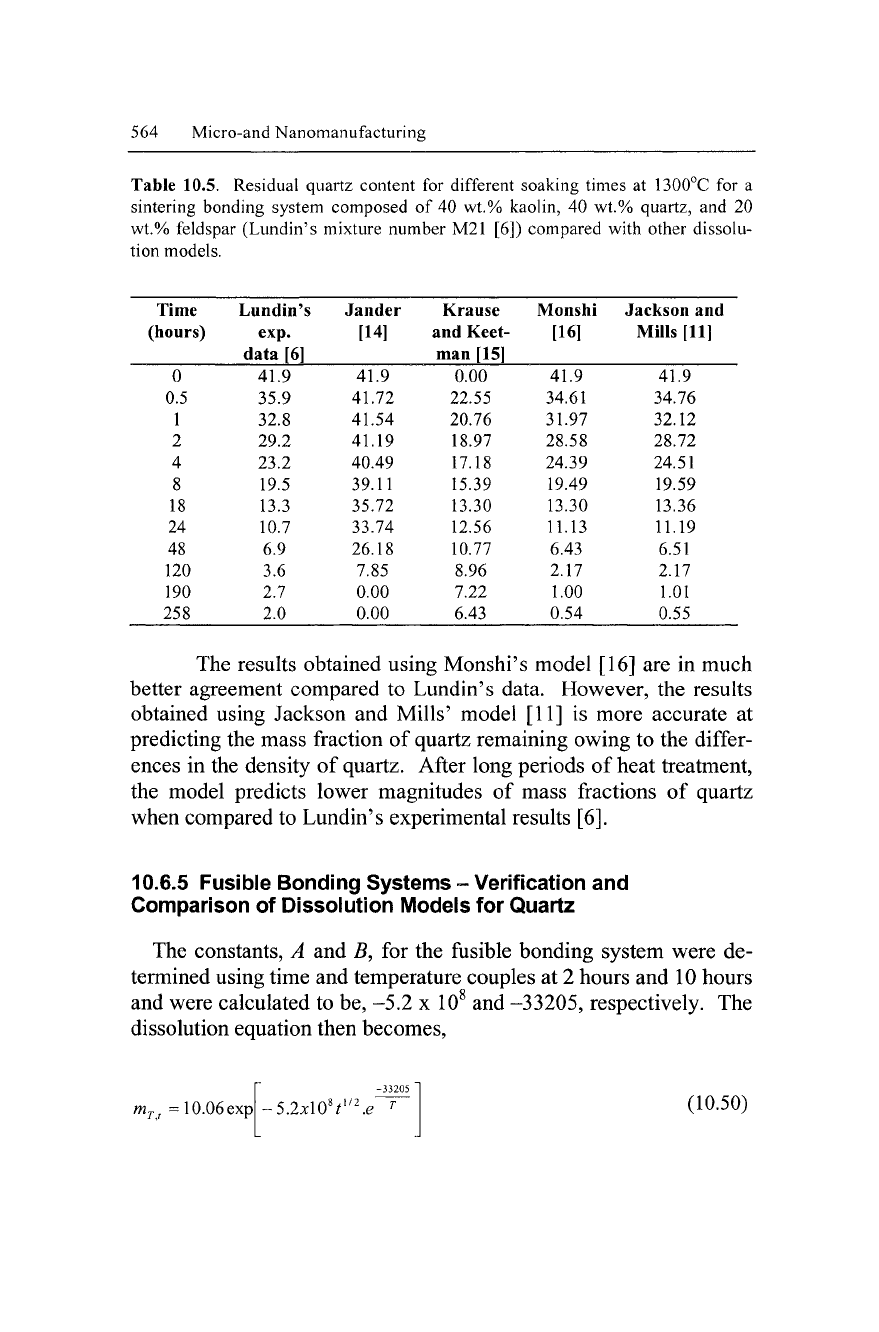
564 Micro-and Nanomanufacturing
Table 10.5. Residual quartz content for different soaking times at 1300°C for a
sintering bonding system composed of 40 wt.% kaolin, 40 wt.% quartz, and 20
wt.% feldspar (Lundin's mixture number M21 [6]) compared with other dissolu-
tion models.
Time
(hours)
~ 0
0.5
1
2
4
8
18
24
48
120
190
258
Lundin's
exp.
data [6]
41.9
35.9
32.8
29.2
23.2
19.5
13.3
10.7
6.9
3.6
2.7
2.0
Jander
[14]
4L9
41.72
41.54
41.19
40.49
39.11
35.72
33.74
26.18
7.85
0.00
0.00
Krause
and Keet-
man [15]
0.00
22.55
20.76
18.97
17.18
15.39
13.30
12.56
10.77
8.96
7.22
6.43
Monshi
[16]
41.9
34.61
31.97
28.58
24.39
19.49
13.30
11.13
6.43
2.17
1.00
0.54
Jackson and
Mills [11]
4L9
34.76
32.12
28.72
24.51
19.59
13.36
11.19
6.51
2.17
1.01
0.55
The results obtained using Monshi's model [16] are in much
better agreement compared to Lundin's data. However, the results
obtained using Jackson and Mills' model [11] is more accurate at
predicting the mass fraction of quartz remaining owing to the differ-
ences in the density of quartz. After long periods of heat treatment,
the model predicts lower magnitudes of mass fractions of quartz
when compared to Lundin's experimental results [6].
10.6.5 Fusible Bonding Systems - Verification and
Comparison of Dissolution Models for Quartz
The constants, A and B, for the fusible bonding system were de-
termined using time and temperature couples at 2 hours and 10 hours
and were calculated to be, -5.2 x 10
8
and -33205, respectively. The
dissolution equation then becomes,
m
Tt
=
10.06 exp
-33205
T
(10.50)
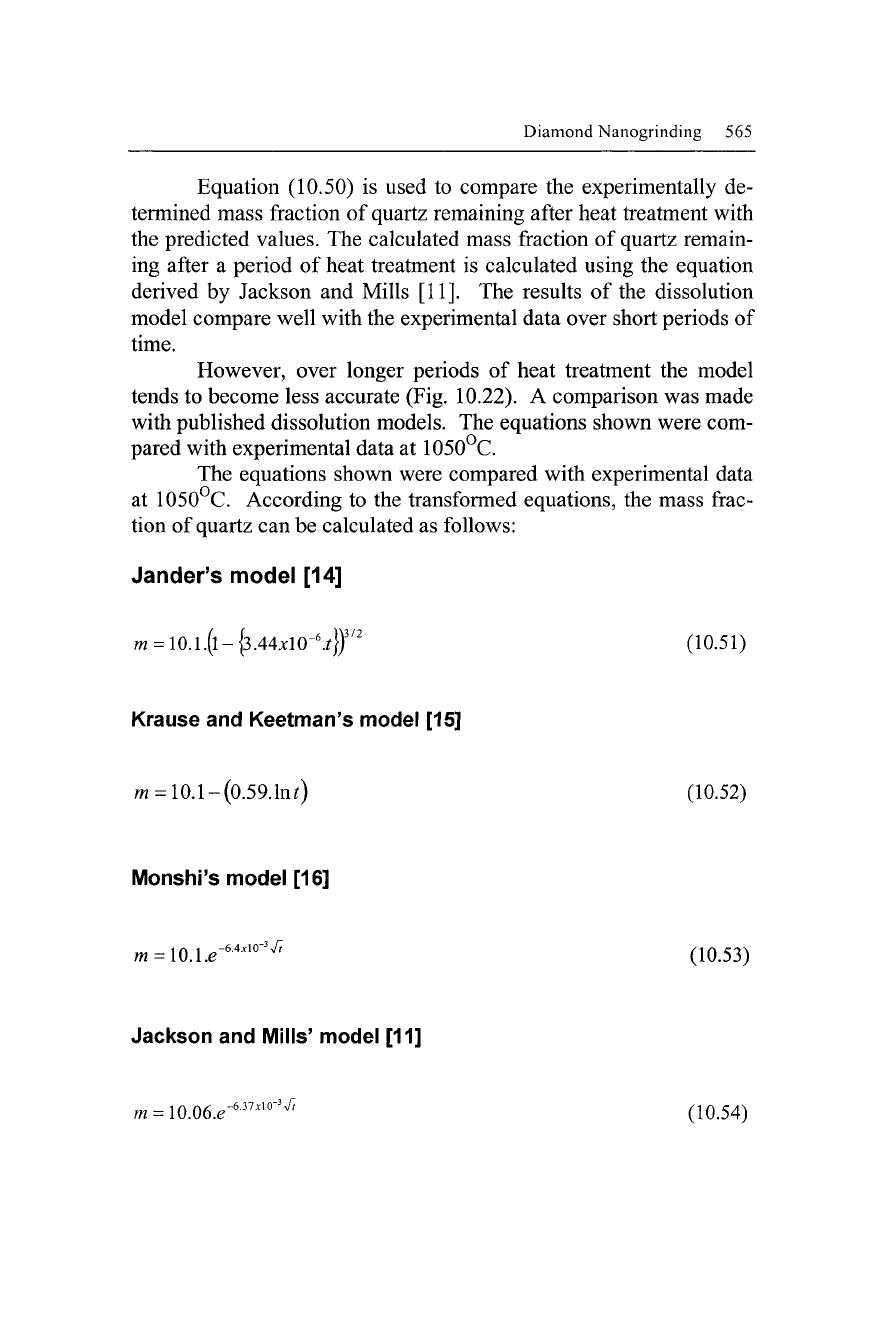
Diamond Nanogrinding 565
Equation (10.50) is used to compare the experimentally de-
termined mass fraction of quartz remaining after heat treatment with
the predicted values. The calculated mass fraction of quartz remain-
ing after a period of heat treatment is calculated using the equation
derived by Jackson and Mills [11]. The results of the dissolution
model compare well with the experimental data over short periods of
time.
However, over longer periods of heat treatment the model
tends to become less accurate (Fig. 10.22). A comparison was made
with published dissolution models. The equations shown were com-
pared with experimental data at 1050°C.
The equations shown were compared with experimental data
at 1050°C. According to the transformed equations, the mass frac-
tion of quartz can be calculated as follows:
Jander's model [14]
m =
10.1.(l
- {3.44xl0"
6
i})
3/2
(10.51)
Krause and Keetman's model [15]
m = 10.1-(0.59.1nf) (10.52)
Monshi's model [16]
m
=
l0.l.e-
64xl0
^
(10.53)
Jackson and Mills' model [11]
m
=
\0.06.e'
6
(10.54)
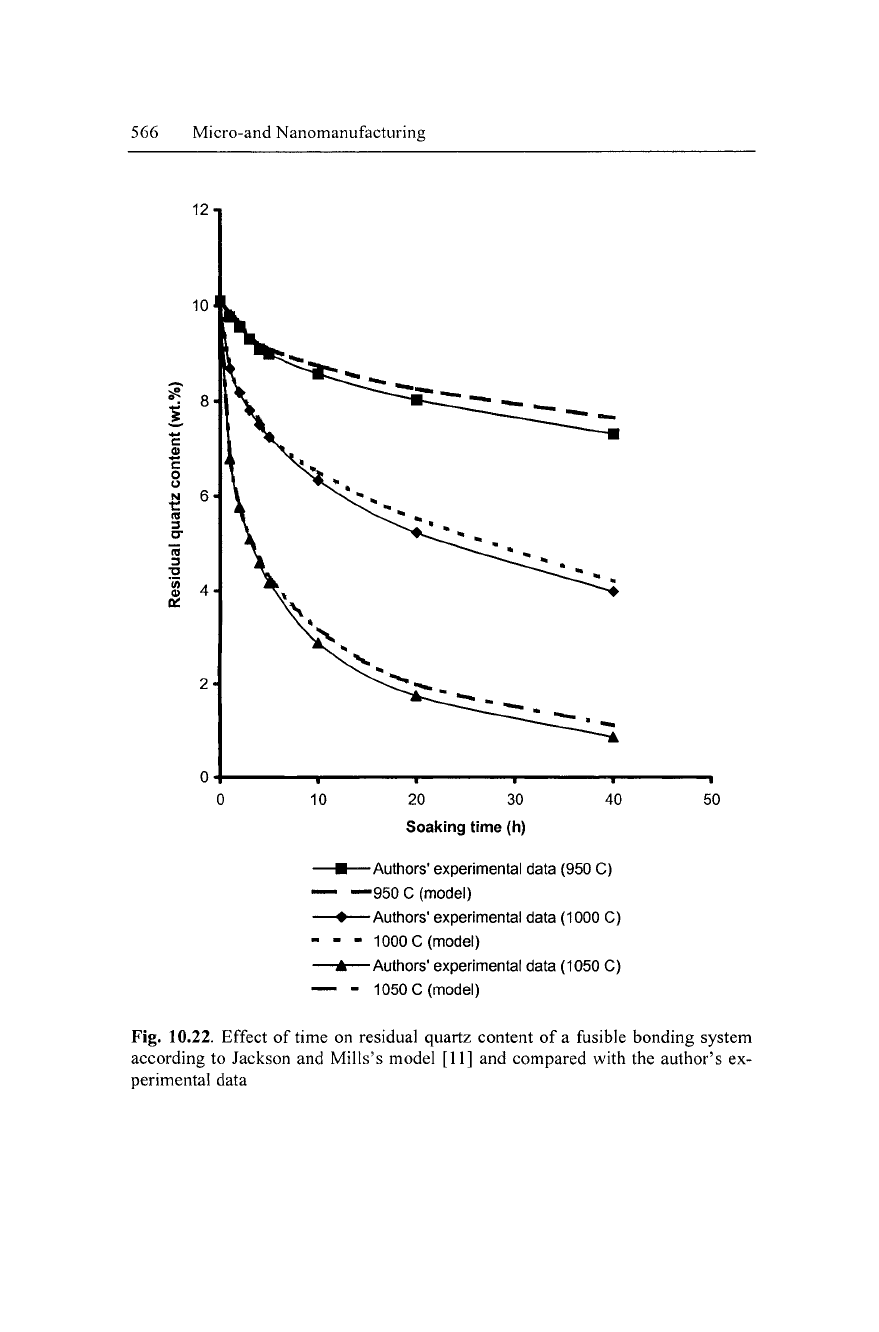
566 Micro-and Nanomanufacturing
12i
Soaking time (h)
-•—Authors' experimental data (950 C)
- —950 C (model)
• Authors' experimental data (1000 C)
- - 1000 C (model)
-A—Authors' experimental data (1050 C)
- - 1050 C (model)
Fig. 10.22. Effect of time on residual quartz content of a fusible bonding system
according to Jackson and Mills's model [11] and compared with the author's ex-
perimental data
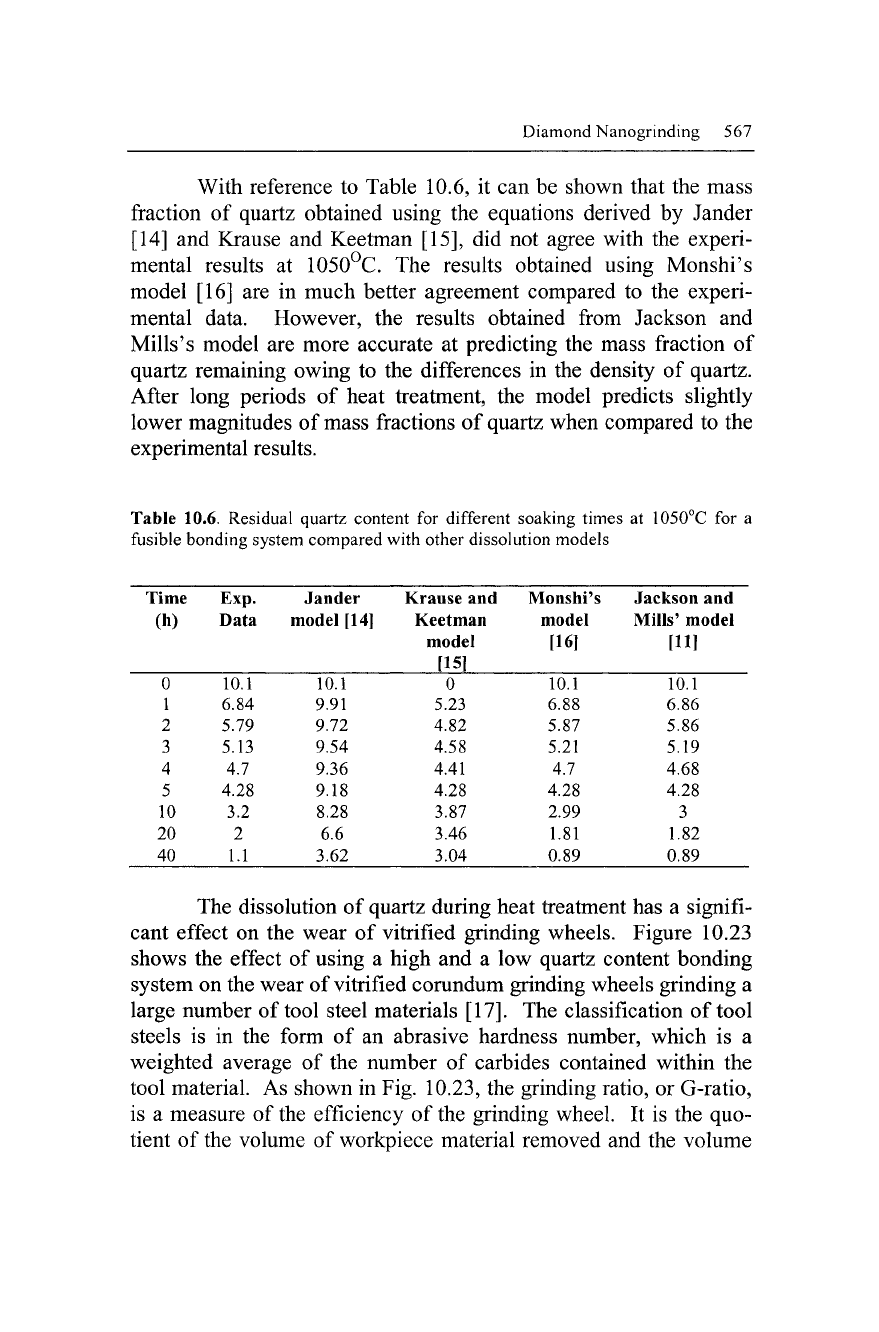
Diamond Nanogrinding 567
With reference to Table 10.6, it can be shown that the mass
fraction of quartz obtained using the equations derived by Jander
[14] and Krause and Keetman [15], did not agree with the experi-
mental results at 1050°C. The results obtained using Monshi's
model [16] are in much better agreement compared to the experi-
mental data. However, the results obtained from Jackson and
Mills's model are more accurate at predicting the mass fraction of
quartz remaining owing to the differences in the density of quartz.
After long periods of heat treatment, the model predicts slightly
lower magnitudes of mass fractions of quartz when compared to the
experimental results.
Table 10.6. Residual quartz content for different soaking times at 1050°C for a
fusible bonding system compared with other dissolution models
Time
(h)
0
1
2
3
4
5
10
20
40
Exp.
Data
10.1
6.84
5.79
5.13
4.7
4.28
3.2
2
1.1
Jander
model [14]
10.1
9.91
9.72
9.54
9.36
9.18
8.28
6.6
3.62
Krause and
Keetman
model
[15]
0
5.23
4.82
4.58
4.41
4.28
3.87
3.46
3.04
Monshi's
model
[16]
10.1
6.88
5.87
5.21
4.7
4.28
2.99
1.81
0.89
Jackson and
Mills'
model
[11]
10.1
6.86
5.86
5.19
4.68
4.28
3
1.82
0.89
The dissolution of quartz during heat treatment has a signifi-
cant effect on the wear of vitrified grinding wheels. Figure 10.23
shows the effect of using a high and a low quartz content bonding
system on the wear of vitrified corundum grinding wheels grinding a
large number of tool steel materials [17]. The classification of tool
steels is in the form of an abrasive hardness number, which is a
weighted average of the number of carbides contained within the
tool material. As shown in Fig.
10.23,
the grinding ratio, or G-ratio,
is a measure of the efficiency of the grinding wheel. It is the quo-
tient of the volume of workpiece material removed and the volume
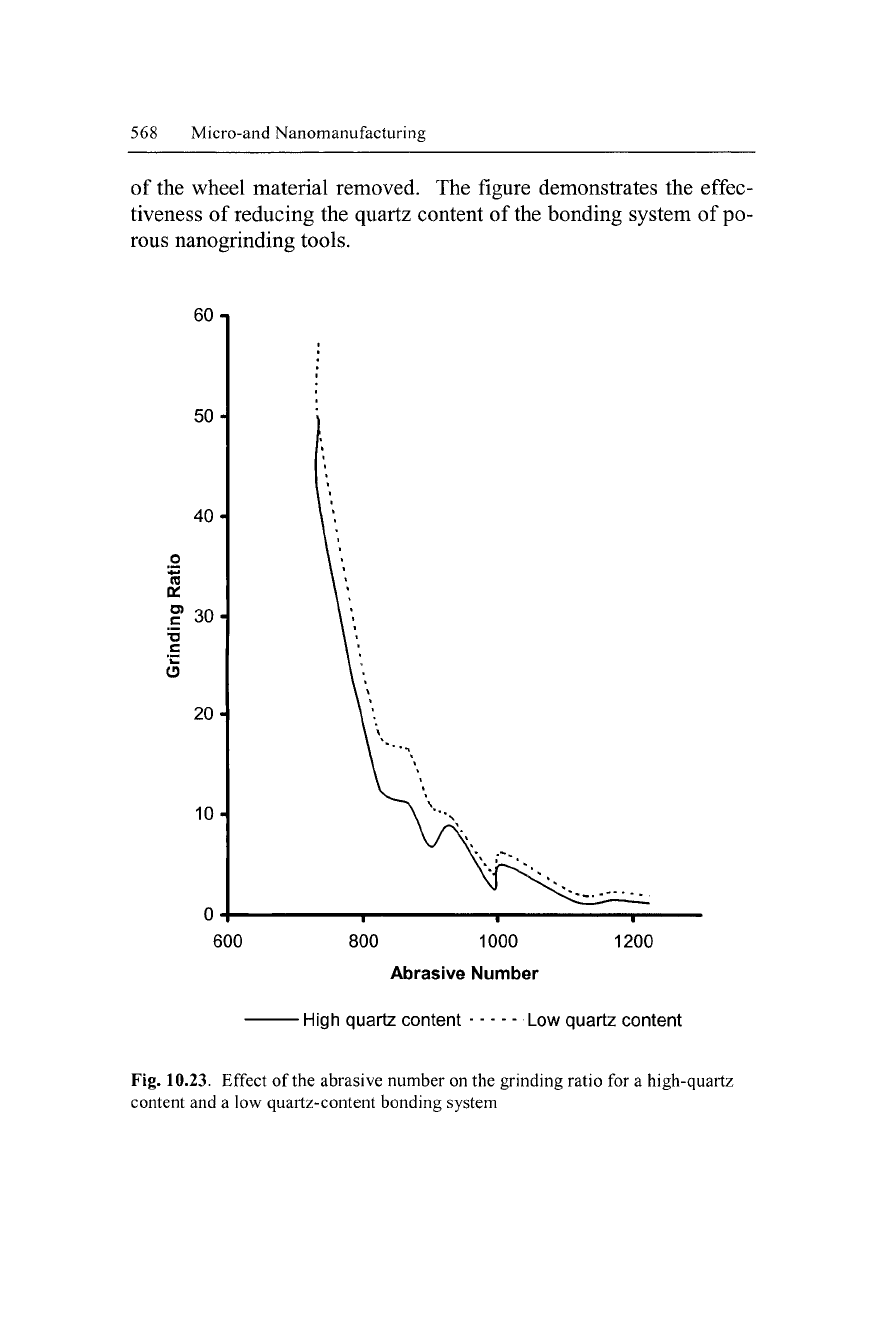
568 Micro-and Nanomanufacturing
of the wheel material removed. The figure demonstrates the effec-
tiveness of reducing the quartz content of the bonding system of po-
rous nanogrinding tools.
60 i
50 J
40 H
(0
.E
30
'•6
c
O
20 A
10 J
600
i
800
i
1000
1200
Abrasive Number
•
High quartz content Low quartz content
Fig.
10.23.
Effect of the abrasive number on the grinding ratio for a high-quartz
content and a low quartz-content bonding system
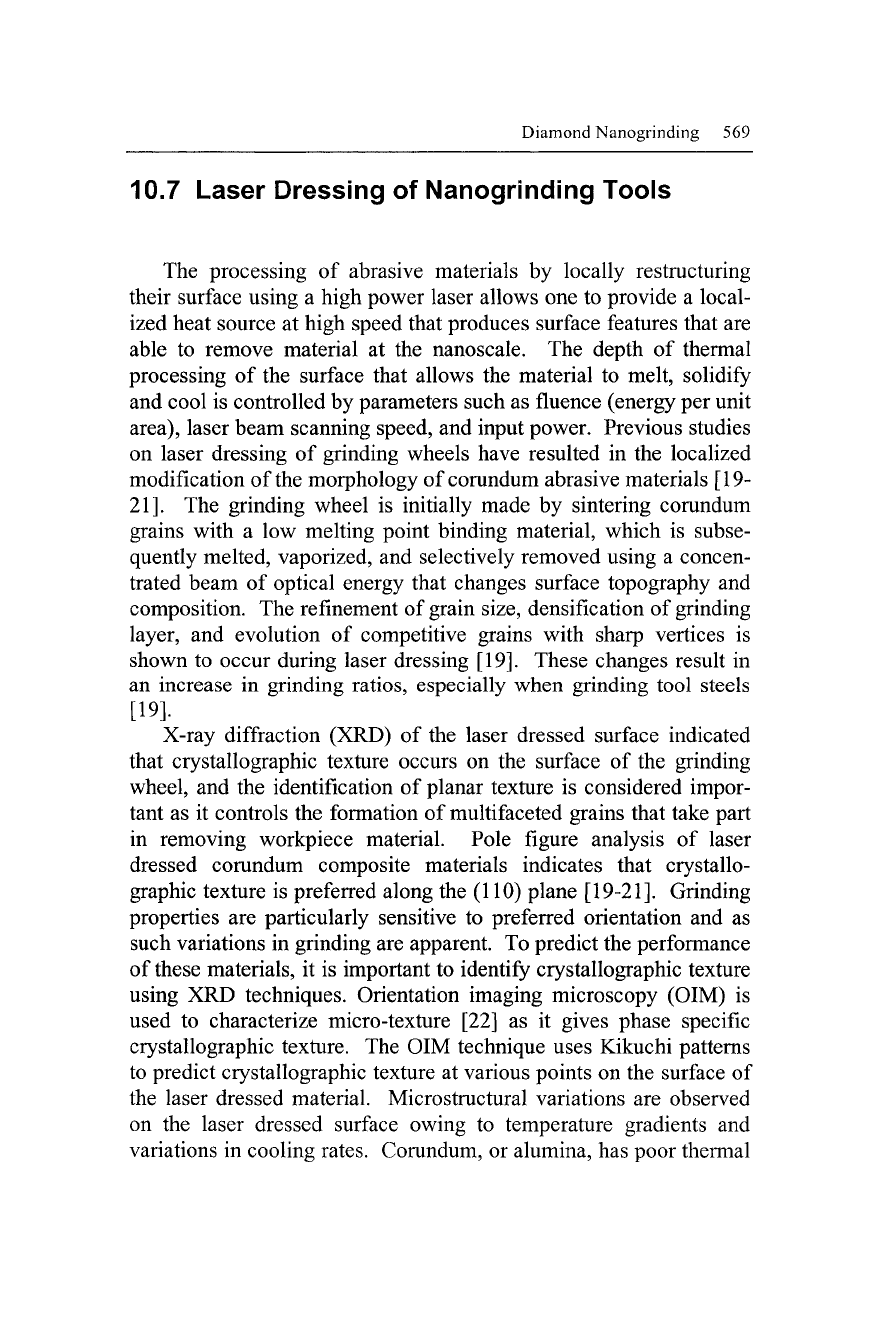
Diamond Nanogrinding 569
10.7 Laser Dressing of Nanogrinding Tools
The processing of abrasive materials by locally restructuring
their surface using a high power laser allows one to provide a local-
ized heat source at high speed that produces surface features that are
able to remove material at the nanoscale. The depth of thermal
processing of the surface that allows the material to melt, solidify
and cool is controlled by parameters such as fluence (energy per unit
area),
laser beam scanning speed, and input power. Previous studies
on laser dressing of grinding wheels have resulted in the localized
modification of the morphology of corundum abrasive materials [19-
21].
The grinding wheel is initially made by sintering corundum
grains with a low melting point binding material, which is subse-
quently melted, vaporized, and selectively removed using a concen-
trated beam of optical energy that changes surface topography and
composition. The refinement of grain size, densification of grinding
layer, and evolution of competitive grains with sharp vertices is
shown to occur during laser dressing [19]. These changes result in
an increase in grinding ratios, especially when grinding tool steels
[19].
X-ray diffraction (XRD) of the laser dressed surface indicated
that crystallographic texture occurs on the surface of the grinding
wheel, and the identification of planar texture is considered impor-
tant as it controls the formation of multifaceted grains that take part
in removing workpiece material. Pole figure analysis of laser
dressed corundum composite materials indicates that crystallo-
graphic texture is preferred along the (110) plane [19-21]. Grinding
properties are particularly sensitive to preferred orientation and as
such variations in grinding are apparent. To predict the performance
of these materials, it is important to identify crystallographic texture
using XRD techniques. Orientation imaging microscopy (OIM) is
used to characterize micro-texture [22] as it gives phase specific
crystallographic texture. The OIM technique uses Kikuchi patterns
to predict crystallographic texture at various points on the surface of
the laser dressed material. Microstructural variations are observed
on the laser dressed surface owing to temperature gradients and
variations in cooling rates. Corundum, or alumina, has poor thermal
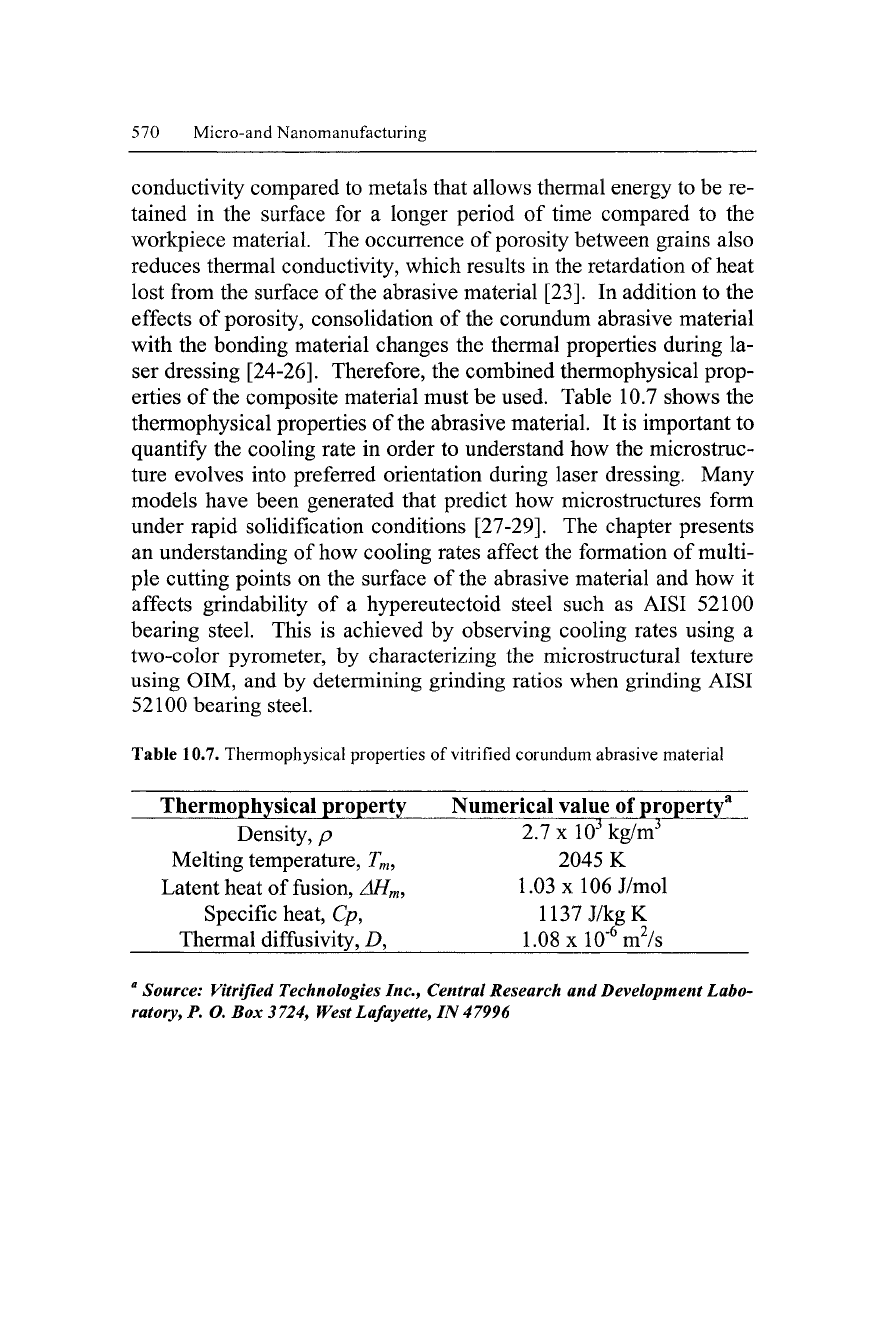
570 Micro-and Nanomanufacturing
conductivity compared to metals that allows thermal energy to be re-
tained in the surface for a longer period of time compared to the
workpiece material. The occurrence of porosity between grains also
reduces thermal conductivity, which results in the retardation of heat
lost from the surface of the abrasive material [23]. In addition to the
effects of porosity, consolidation of the corundum abrasive material
with the bonding material changes the thermal properties during la-
ser dressing [24-26]. Therefore, the combined thermophysical prop-
erties of the composite material must be used. Table 10.7 shows the
thermophysical properties of the abrasive material. It is important to
quantify the cooling rate in order to understand how the microstruc-
ture evolves into preferred orientation during laser dressing. Many
models have been generated that predict how microstructures form
under rapid solidification conditions [27-29]. The chapter presents
an understanding of how cooling rates affect the formation of multi-
ple cutting points on the surface of the abrasive material and how it
affects grindability of a hypereutectoid steel such as AISI 52100
bearing steel. This is achieved by observing cooling rates using a
two-color pyrometer, by characterizing the microstructural texture
using OIM, and by determining grinding ratios when grinding AISI
52100 bearing steel.
Table 10.7. Thermophysical properties of vitrified corundum abrasive material
Thermophysical property Numerical value of property**
Density, p 2.7xl0
3
kg/m
J
Melting temperature, T
m
, 2045 K
Latent heat of fusion, AH
m
, 1.03 x 106 J/mol
Specific heat, Cp, 1137 J/kg K
Thermal diffusivity, D, 1.08 x 10"
6
m
2
/s
"Source: Vitrified Technologies Inc., Central Research and Development Labo-
ratory, P. O. Box 3724, West Lafayette, IN 47996
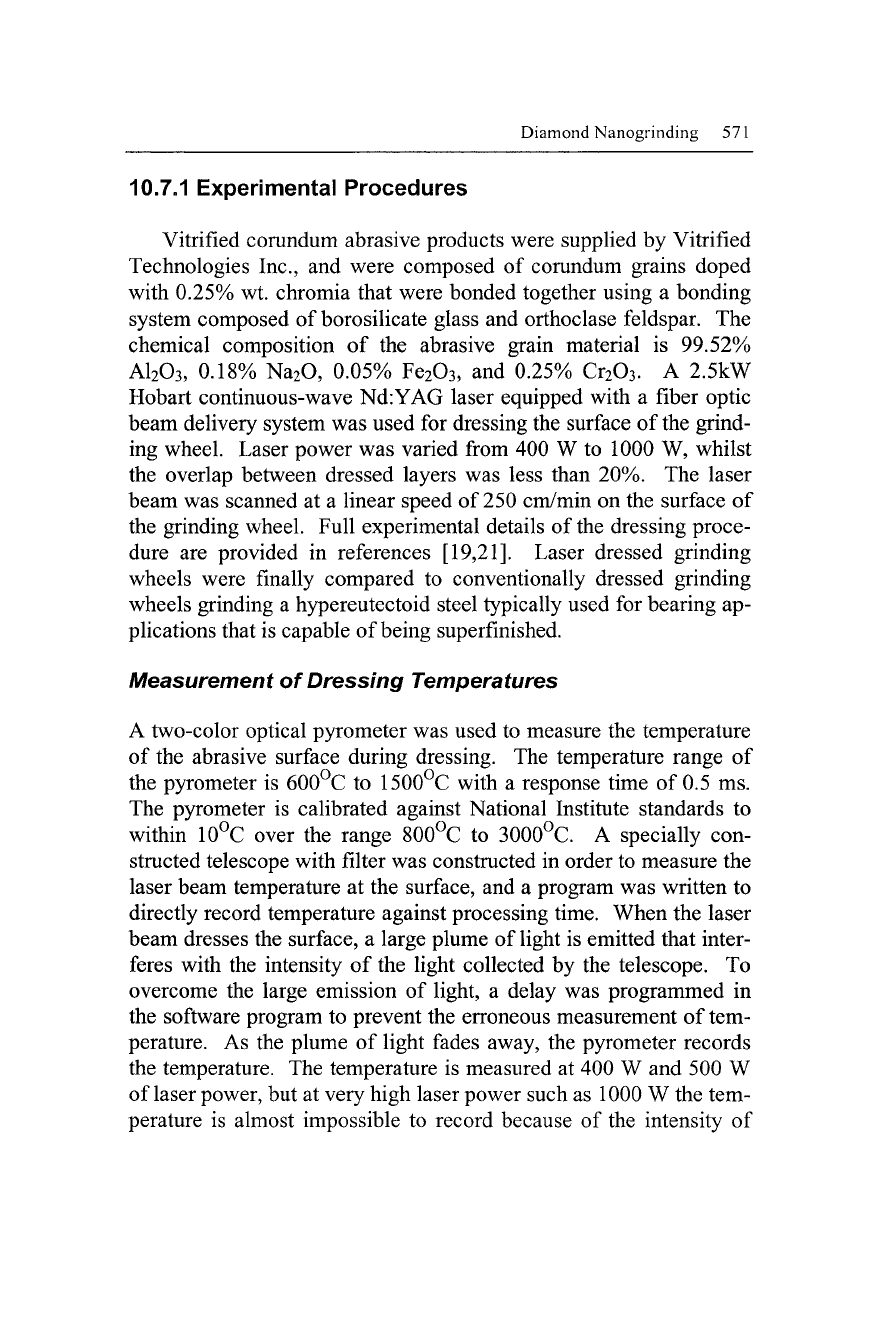
Diamond Nanogrinding 571
10.7.1 Experimental Procedures
Vitrified corundum abrasive products were supplied by Vitrified
Technologies Inc., and were composed of corundum grains doped
with 0.25% wt. chromia that were bonded together using a bonding
system composed of borosilicate glass and orthoclase feldspar. The
chemical composition of the abrasive grain material is 99.52%
A1
2
0
3
,
0.18% Na
2
0, 0.05% Fe
2
0
3
, and 0.25% Cr
2
0
3
. A 2.5kW
Hobart continuous-wave Nd:YAG laser equipped with a fiber optic
beam delivery system was used for dressing the surface of the grind-
ing wheel. Laser power was varied from 400 W to 1000 W, whilst
the overlap between dressed layers was less than 20%. The laser
beam was scanned at a linear speed of 250 cm/min on the surface of
the grinding wheel. Full experimental details of the dressing proce-
dure are provided in references [19,21]. Laser dressed grinding
wheels were finally compared to conventionally dressed grinding
wheels grinding a hypereutectoid steel typically used for bearing ap-
plications that is capable of being superfinished.
Measurement of Dressing Temperatures
A two-color optical pyrometer was used to measure the temperature
of the abrasive surface during dressing. The temperature range of
the pyrometer is 600°C to 1500°C with a response time of 0.5 ms.
The pyrometer is calibrated against National Institute standards to
within 10°C over the range 800°C to 3000°C. A specially con-
structed telescope with filter was constructed in order to measure the
laser beam temperature at the surface, and a program was written to
directly record temperature against processing time. When the laser
beam dresses the surface, a large plume of light is emitted that inter-
feres with the intensity of the light collected by the telescope. To
overcome the large emission of light, a delay was programmed in
the software program to prevent the erroneous measurement of tem-
perature. As the plume of light fades away, the pyrometer records
the temperature. The temperature is measured at 400 W and 500 W
of laser power, but at very high laser power such as 1000 W the tem-
perature is almost impossible to record because of the intensity of
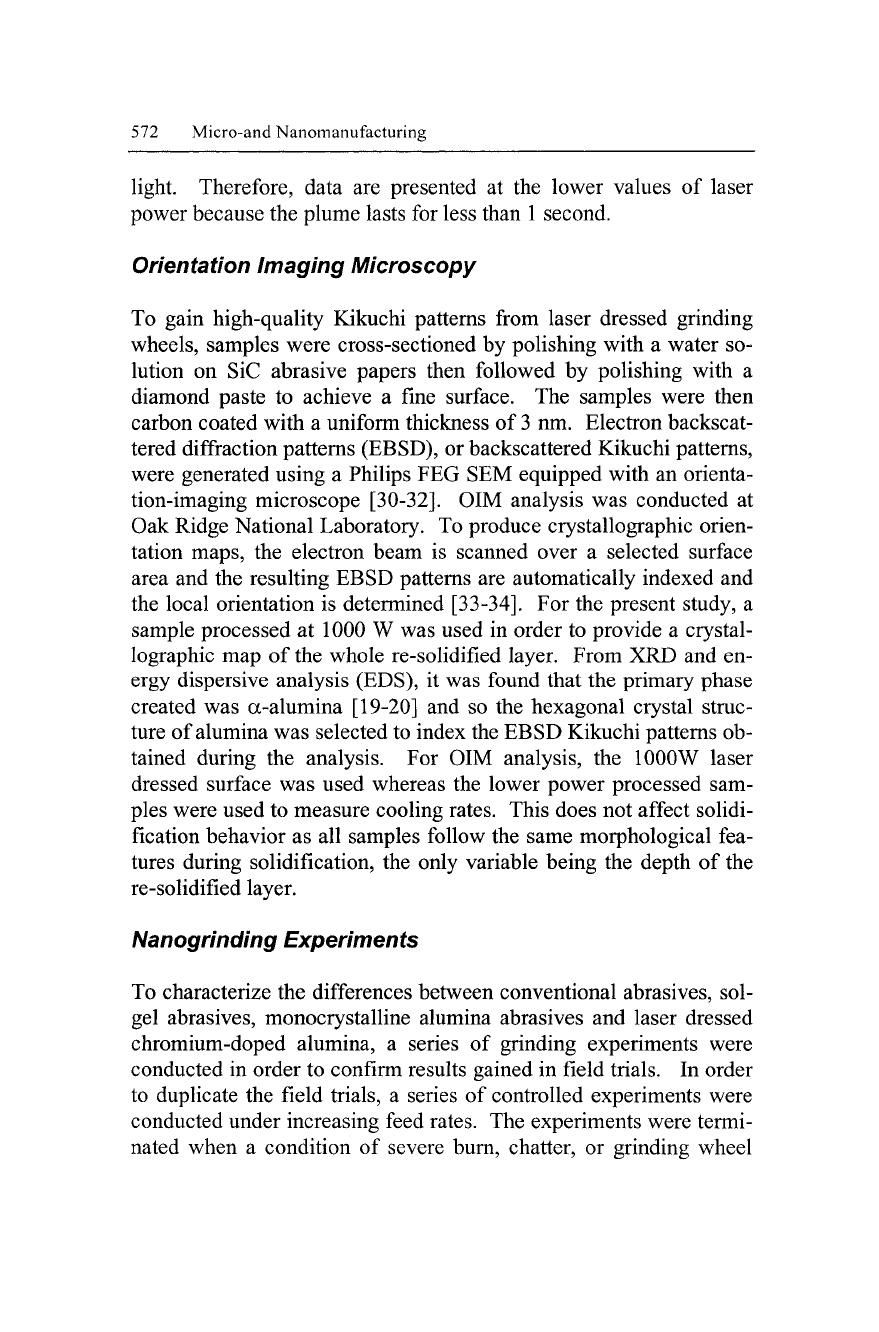
572 Micro-and Nanomanufacturing
light. Therefore, data are presented at the lower values of laser
power because the plume lasts for less than
1
second.
Orientation Imaging Microscopy
To gain high-quality Kikuchi patterns from laser dressed grinding
wheels, samples were cross-sectioned by polishing with a water so-
lution on SiC abrasive papers then followed by polishing with a
diamond paste to achieve a fine surface. The samples were then
carbon coated with a uniform thickness of
3
nm. Electron backscat-
tered diffraction patterns (EBSD), or backscattered Kikuchi patterns,
were generated using a Philips FEG SEM equipped with an orienta-
tion-imaging microscope [30-32]. OIM analysis was conducted at
Oak Ridge National Laboratory. To produce crystallographic orien-
tation maps, the electron beam is scanned over a selected surface
area and the resulting EBSD patterns are automatically indexed and
the local orientation is determined [33-34]. For the present study, a
sample processed at 1000 W was used in order to provide a crystal-
lographic map of the whole re-solidified layer. From XRD and en-
ergy dispersive analysis (EDS), it was found that the primary phase
created was oc-alumina [19-20] and so the hexagonal crystal struc-
ture of alumina was selected to index the EBSD Kikuchi patterns ob-
tained during the analysis. For OIM analysis, the 1000W laser
dressed surface was used whereas the lower power processed sam-
ples were used to measure cooling rates. This does not affect solidi-
fication behavior as all samples follow the same morphological fea-
tures during solidification, the only variable being the depth of the
re-solidified layer.
Nanogrinding Experiments
To characterize the differences between conventional abrasives, sol-
gel abrasives, monocrystalline alumina abrasives and laser dressed
chromium-doped alumina, a series of grinding experiments were
conducted in order to confirm results gained in field trials. In order
to duplicate the field trials, a series of controlled experiments were
conducted under increasing feed rates. The experiments were termi-
nated when a condition of severe burn, chatter, or grinding wheel
